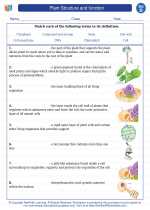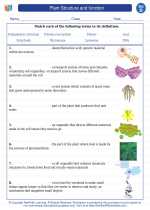Plant Structure and function -> fossil record
The Fossil Record
The fossil record is a collection of all the fossils that have been discovered throughout the world. Fossils are the preserved remains or traces of ancient organisms, and they provide valuable information about the history of life on Earth.
Formation of Fossils
Fossils are formed through a process called fossilization. When an organism dies, its remains can become buried in sediment such as mud, sand, or silt. Over time, the layers of sediment build up and compress the remains, eventually turning them into rock. This process preserves the shape and structure of the organism, creating a fossil.
Types of Fossils
There are several different types of fossils, including:
- Body Fossils: These are the actual remains of an organism, such as bones, teeth, or shells.
- Trace Fossils: These are the traces left behind by an organism, such as footprints, burrows, or nests.
- Mineral Replacement Fossils: In this type of fossilization, the original materials of the organism are replaced by minerals, preserving the organism's structure.
Importance of the Fossil Record
The fossil record is important because it provides evidence for the evolution of life on Earth. By studying fossils, scientists can learn about the types of organisms that lived in the past, their behaviors, and how they were related to each other. Fossils also help us understand how environments have changed over time and how species have adapted to these changes.
Studying the Fossil Record
When studying the fossil record, scientists use various techniques to analyze and interpret the information preserved in fossils. These techniques include:
- Relative Dating: This method involves determining the age of a fossil by comparing its position in rock layers to other fossils.
- Absolute Dating: Using techniques such as radiometric dating to determine the actual age of a fossil.
- Comparative Anatomy: Studying the structures of ancient and modern organisms to understand their evolutionary relationships.
- Paleoecology: Examining the relationships between ancient organisms and their environments.
Study Guide
Here are some key points to remember when studying the fossil record:
- Define what a fossil is and how it is formed.
- Identify the different types of fossils and provide examples of each.
- Explain the importance of the fossil record in understanding the history of life on Earth.
- Describe the techniques used to study and interpret the fossil record, including relative and absolute dating, comparative anatomy, and paleoecology.
By understanding the fossil record, we can gain insights into the diversity of life that has existed on Earth and the processes that have shaped it over millions of years.
[Fossil Record] Related Worksheets and Study Guides:
.◂Science Worksheets and Study Guides Fourth Grade. Plant Structure and function

 Worksheet/Answer key
Worksheet/Answer key
 Worksheet/Answer key
Worksheet/Answer key
 Worksheet/Answer key
Worksheet/Answer key
 Vocabulary/Answer key
Vocabulary/Answer key
 Vocabulary/Answer key
Vocabulary/Answer key
 Vocabulary/Answer key
Vocabulary/Answer key
 Vocabulary/Answer key
Vocabulary/Answer key
